- Mozart: Le nozze di Figaro
- Giulini / Philharmonia Orchestra (EMI CMS
7632662)
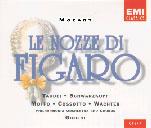 Giulini’s stereo studio
Nozze (rec. 1959) is justly considered one of the best on
disc and at mid-price it can’t be beat. The cast is solid gold.
Taddei is a great Figaro, Anna Moffo a warmly loveable Susanna,
Eberhard Wächter is a buffo-ish Count, Schwarzkopf is a rather
self-conscious Countess, Ivo Vinco’s Bartolo is a bit hammy and
Commendator-ish, Fiorenza Cossotto’s deep mezzo puts unwonted hair
on Cherubino’s chest. Guilini provides intelligent, deferential
accompaniment. The studio acoustic is dry and honest. Libretto in
Italian and English only. In short, a reference recording. Giulini’s stereo studio
Nozze (rec. 1959) is justly considered one of the best on
disc and at mid-price it can’t be beat. The cast is solid gold.
Taddei is a great Figaro, Anna Moffo a warmly loveable Susanna,
Eberhard Wächter is a buffo-ish Count, Schwarzkopf is a rather
self-conscious Countess, Ivo Vinco’s Bartolo is a bit hammy and
Commendator-ish, Fiorenza Cossotto’s deep mezzo puts unwonted hair
on Cherubino’s chest. Guilini provides intelligent, deferential
accompaniment. The studio acoustic is dry and honest. Libretto in
Italian and English only. In short, a reference recording.
- Mozart: Le nozze di Figaro
- Karl Böhm / Vienna Philharmonic
- (Orfeo C296 923D / Pelleas)
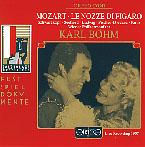 The Orfeo label scored
quite a coup licensing the Austrian Radio tapes of Salzburg Festival
performances between 1949 and 1985. This excellent July 30, 1957
Le nozze di Figaro led by master Mozartian Karl Böhm is a
valuable memento. The all-star cast includes the young
Fischer-Dieskau as an intimidating Count with perfect diction and
infallible thespian instincts. Irmgard Seefried’s vocally and
dramatically impeccable Susanna is a pillar of the production.
English tenor Murray Dickie (Basilio) sings better Italian than many
of his colleagues. Elisabeth Schwarzkopf, a legendary Countess, is
in top form. Christa Ludwig, the audience’s favourite, is a palpably
excited Cherubino. The other two principals are not at their best.
Erich Kunz (Figaro) sounds indisposed, rarely singing out. George
Stern (Bartolo) sings stilted Italian in a bland bass voice. The
orchestra under Böhm is a joy and the well-behaved Festival audience
is silent as the tomb. In short, this is a studio-quality
performance to study and cherish, packed with superb performances by
the best Mozart singers of the era. Note that the same performance
is also available on the budget Gala label (GL 1000.601).
Mozart’s Le Nozze di Figaro at L’Opéra de Montreal April
23-29, 1998 (Tel: 514-985-2258) and L’Opéra de Québec May 9, 12, 14,
16, 1998 (Tel: 418-529-4142). The Orfeo label scored
quite a coup licensing the Austrian Radio tapes of Salzburg Festival
performances between 1949 and 1985. This excellent July 30, 1957
Le nozze di Figaro led by master Mozartian Karl Böhm is a
valuable memento. The all-star cast includes the young
Fischer-Dieskau as an intimidating Count with perfect diction and
infallible thespian instincts. Irmgard Seefried’s vocally and
dramatically impeccable Susanna is a pillar of the production.
English tenor Murray Dickie (Basilio) sings better Italian than many
of his colleagues. Elisabeth Schwarzkopf, a legendary Countess, is
in top form. Christa Ludwig, the audience’s favourite, is a palpably
excited Cherubino. The other two principals are not at their best.
Erich Kunz (Figaro) sounds indisposed, rarely singing out. George
Stern (Bartolo) sings stilted Italian in a bland bass voice. The
orchestra under Böhm is a joy and the well-behaved Festival audience
is silent as the tomb. In short, this is a studio-quality
performance to study and cherish, packed with superb performances by
the best Mozart singers of the era. Note that the same performance
is also available on the budget Gala label (GL 1000.601).
Mozart’s Le Nozze di Figaro at L’Opéra de Montreal April
23-29, 1998 (Tel: 514-985-2258) and L’Opéra de Québec May 9, 12, 14,
16, 1998 (Tel: 418-529-4142).
- Puccini: Madama Butterfly
- Oliviero de Fabritiis/ Rome Opera (Pearl GEMM
CDS 9290/SRI)
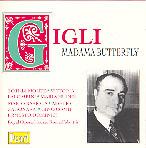 This July 1939
Butterfly was the opera’s second complete commercial
recording and still remains an emotionally moving performance. For
pure dramatic realism - you can easily visualise the story through
the voices - it is second to none. If you don’t mind some period
pratices (for me they constitute the fascination of this recording)
and the sonic limitations of transfers from 78 rpm discs, there is a
wealth of pleasure here. Tenor Beniamino Gigli is the star of this
set. His sunny timbre, easy delivery and buoyancy remain unique.
Toti dal Monti’s shrill timbre is an acquired taste but her
technique (what legato and messa di voce!) are stunning. Unusual
characterizations include Zagonara’s Goro (as villainous as a
Nibelung) and Basiola’s surprisingly macho, sleazy Sharpless. De
Fabritiis is a genius, with impeccable rhythm and perfect stage-pit
coordination. Despite surface noise and blasting at fortes, highly
recommended. Madama Butterfly at Toronto’s Canadian Opera Company
April 9, 14, 17, 19, 22, 25, 1998 Tel: 1-800-250-4653 /
416-363-8231. E-mail: tickets@coc.ca This July 1939
Butterfly was the opera’s second complete commercial
recording and still remains an emotionally moving performance. For
pure dramatic realism - you can easily visualise the story through
the voices - it is second to none. If you don’t mind some period
pratices (for me they constitute the fascination of this recording)
and the sonic limitations of transfers from 78 rpm discs, there is a
wealth of pleasure here. Tenor Beniamino Gigli is the star of this
set. His sunny timbre, easy delivery and buoyancy remain unique.
Toti dal Monti’s shrill timbre is an acquired taste but her
technique (what legato and messa di voce!) are stunning. Unusual
characterizations include Zagonara’s Goro (as villainous as a
Nibelung) and Basiola’s surprisingly macho, sleazy Sharpless. De
Fabritiis is a genius, with impeccable rhythm and perfect stage-pit
coordination. Despite surface noise and blasting at fortes, highly
recommended. Madama Butterfly at Toronto’s Canadian Opera Company
April 9, 14, 17, 19, 22, 25, 1998 Tel: 1-800-250-4653 /
416-363-8231. E-mail: tickets@coc.ca
- Handel: Ariodante
- Marc Minkowski / Les Musiciens du Louvre
- Deutsche Grammophon Archiv 457-271-2
-
- Handel: Ariodante
- Nicholas McGegan / Freiburger Barockorchester
- harmonia mundi HMU 907146.48
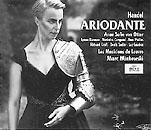 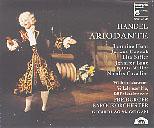 There are now two great Ariodante
recordings in the catalogue that beg comparison: Nick McGegan’s 1995
Göttingen Handel Festival recording for harmonia mundi, and
Minkowski’s new release on DG. McGegan’s Ariodante was a
definitive delight when it first appeared and it remains a gem, but
Minkowski has trumped him at almost every point. Conducting from the
harpsichord, McGegan leads a stately, rather prissy performance
compared to the unabashedly romantic Minkowski. McGegan has a cast
of baroque vocal stars but Minkowski’s singers, while marginally
less authentic, bring more humanity to their roles. Minkowski’s
Ginevra (Lyne Dawson) is far more powerful and vibrant than
McGegan’s Juliana Gondek; his King, Russian bass Denis Sedov, is
more resonant and agile than McGegan’s Nicolas Cavallier; the
Dalindas are about the same. Minkowski's employment of non-baroque
specialists for the remaining roles may irk purists. Richard Croft’s
sobbing Lurcanio is more verismo than baroque, but it works.
Minkowski’s Ariodante, Anne Sofie von Otter, is a bit out
of her depth executing (or faking) Baroque runs, shakes and trills.
She is at her best in the gorgeous duets with Dawson ("Prendi da
questa mano" and "Se rinasce") but in the final analysis, McGegan’s
Ariodante (baroque diva Lorraine Hunt) trounces von Otter on
technical points alone. Minkowski deserves praise for casting Polish
contralto Eva Podles in the pants part of Polinesso, Duke of Albany.
Her androgynous timbre and startling range (from amphibious chest
voice to clarion top) make her Polinesso unforgettable. Minkowski
and McGegan both have crack orchestras and choruses, and excellent
recorded sound. McGegan’s effort will always deserve respect but for
a sheerly thrilling Ariodante, try Minkowski. There are now two great Ariodante
recordings in the catalogue that beg comparison: Nick McGegan’s 1995
Göttingen Handel Festival recording for harmonia mundi, and
Minkowski’s new release on DG. McGegan’s Ariodante was a
definitive delight when it first appeared and it remains a gem, but
Minkowski has trumped him at almost every point. Conducting from the
harpsichord, McGegan leads a stately, rather prissy performance
compared to the unabashedly romantic Minkowski. McGegan has a cast
of baroque vocal stars but Minkowski’s singers, while marginally
less authentic, bring more humanity to their roles. Minkowski’s
Ginevra (Lyne Dawson) is far more powerful and vibrant than
McGegan’s Juliana Gondek; his King, Russian bass Denis Sedov, is
more resonant and agile than McGegan’s Nicolas Cavallier; the
Dalindas are about the same. Minkowski's employment of non-baroque
specialists for the remaining roles may irk purists. Richard Croft’s
sobbing Lurcanio is more verismo than baroque, but it works.
Minkowski’s Ariodante, Anne Sofie von Otter, is a bit out
of her depth executing (or faking) Baroque runs, shakes and trills.
She is at her best in the gorgeous duets with Dawson ("Prendi da
questa mano" and "Se rinasce") but in the final analysis, McGegan’s
Ariodante (baroque diva Lorraine Hunt) trounces von Otter on
technical points alone. Minkowski deserves praise for casting Polish
contralto Eva Podles in the pants part of Polinesso, Duke of Albany.
Her androgynous timbre and startling range (from amphibious chest
voice to clarion top) make her Polinesso unforgettable. Minkowski
and McGegan both have crack orchestras and choruses, and excellent
recorded sound. McGegan’s effort will always deserve respect but for
a sheerly thrilling Ariodante, try Minkowski.
- Samuel Barber: Complete Piano
Music
- John Browning , piano
- Music Masters 01612-67122-2 / BMG
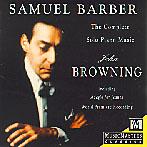 Legendary American
pianist John Browning (b. 1933), has been staging a comeback at an
age when most musicians contemplate retirement. Because Browning’s
playing is still marvellous, we can count ourselves lucky. I loved
his Mozart concerto at New York's Mostly Mozart Festivallast summer
and this disc of Barber’s solo piano music is equally impressive.
Browning is justly regarded as the definitive interpreter of his
friend Sam Barber’s piano music. Here he plays the virtuosic Piano
Sonata, Op. 26 (1949), the delightfully jazzy Excursions (1942-44)
and the Nocturne, Op. 33 (1058) which he premiered thirty years ago.
Despite claims of completeness, Browning omits the piano arrangement
of Barber’s Souvenirs op. 28 (1952) which has been recorded by Ruth
Laredo (Elektra/Nonesuch) and Parkin (Chandos), among others.
Browning’s delicate touch , emotional sensitivity and technical
prowess make this a treasurable recording. John Browning plays
Barber’s Piano Concerto (which he has played over 600 times
since it was written for him in 1962 ) with the Toronto Symphony
Orchestra April 18 &20, 1998. Tel: 416-593-4828. Legendary American
pianist John Browning (b. 1933), has been staging a comeback at an
age when most musicians contemplate retirement. Because Browning’s
playing is still marvellous, we can count ourselves lucky. I loved
his Mozart concerto at New York's Mostly Mozart Festivallast summer
and this disc of Barber’s solo piano music is equally impressive.
Browning is justly regarded as the definitive interpreter of his
friend Sam Barber’s piano music. Here he plays the virtuosic Piano
Sonata, Op. 26 (1949), the delightfully jazzy Excursions (1942-44)
and the Nocturne, Op. 33 (1058) which he premiered thirty years ago.
Despite claims of completeness, Browning omits the piano arrangement
of Barber’s Souvenirs op. 28 (1952) which has been recorded by Ruth
Laredo (Elektra/Nonesuch) and Parkin (Chandos), among others.
Browning’s delicate touch , emotional sensitivity and technical
prowess make this a treasurable recording. John Browning plays
Barber’s Piano Concerto (which he has played over 600 times
since it was written for him in 1962 ) with the Toronto Symphony
Orchestra April 18 &20, 1998. Tel: 416-593-4828.
- Penderecki: Violin Concerto No. 2
- Bartok: Violin Sonata No. 2
- Anne-Sophie Mutter, violin
- K. Penderecki/ London Symphony
Orchestra
- Deutsche Grammophom 453-507-2
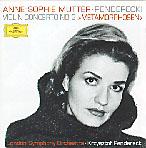 Any world premiere
recording of a concerto by Penderecki, played by the artist for whom
it was written is to be recommended (especially if that artist is
phenomenal violinist Anne-Sophie Mutter). Penderecki and Mutter have
worked closely to maximize the impact of his concerto, and the
collaboration is a success. The concerto is a huge 38-minute
densely-textured work with passages of classic Penderecki (trilled
clusters on strings, etc.) and long stretches of virtuoso violin
writing (as usual, Penderecki treats the instrument as a voice).
Deutsche Grammophon’s publicity emphasizes the accessibility of this
concerto, and certainly there is nothing here to scare the horses.
It lacks the immediate visceral impact of Penderecki’s earlier, more
engagé masterpieces. Still, the disc is an audiophile’s
dream, well worth having for the London Symphony and Mutter’s
ravishing playing. Anne-Sophie Mutter will play the complete
Beethoven violin sonatas at Toronto’s Ford Centre for the Performing
Arts April 16, 17, 18, 1998. 20H00. Ticketmaster: 416-872-2222. Any world premiere
recording of a concerto by Penderecki, played by the artist for whom
it was written is to be recommended (especially if that artist is
phenomenal violinist Anne-Sophie Mutter). Penderecki and Mutter have
worked closely to maximize the impact of his concerto, and the
collaboration is a success. The concerto is a huge 38-minute
densely-textured work with passages of classic Penderecki (trilled
clusters on strings, etc.) and long stretches of virtuoso violin
writing (as usual, Penderecki treats the instrument as a voice).
Deutsche Grammophon’s publicity emphasizes the accessibility of this
concerto, and certainly there is nothing here to scare the horses.
It lacks the immediate visceral impact of Penderecki’s earlier, more
engagé masterpieces. Still, the disc is an audiophile’s
dream, well worth having for the London Symphony and Mutter’s
ravishing playing. Anne-Sophie Mutter will play the complete
Beethoven violin sonatas at Toronto’s Ford Centre for the Performing
Arts April 16, 17, 18, 1998. 20H00. Ticketmaster: 416-872-2222.
- The Complete Josef Hofmann: Volume
5
- Marston 52004-2 / SRI
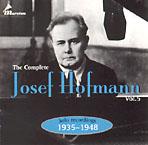 Josef Hofmann
(1876-1957) fut l’un des plus grands pianistes de la première moitié
du 20ème siècle. Dans ses meilleurs moments, son jeu était d’une
perfection pianistique insurpassable. Hofmann possédait une
technique sans failles, une sonorité d’un raffinement exquis et un
sens des couleurs qui n’avait rien à envier à celui
d’Horowitz. Josef Hofmann
(1876-1957) fut l’un des plus grands pianistes de la première moitié
du 20ème siècle. Dans ses meilleurs moments, son jeu était d’une
perfection pianistique insurpassable. Hofmann possédait une
technique sans failles, une sonorité d’un raffinement exquis et un
sens des couleurs qui n’avait rien à envier à celui
d’Horowitz.
La nouvelle compagnie de disques Marston poursuit la réédition du
"Complete Josef Hofmann" avec ce cinquième volume (les quatre
premiers sont disponibles sur étiquette VAI Audio). Le premier CD de
ce volume contient les enregistrements tests que Hofmann fit pour
RCA en Amérique ainsi que pour HMV à Londres en 1935. Certaines de
ces pièces étaient déjà disponibles sur Appian, avec un transfert
peu réussi, dans le premier volume de "Romantic Piano Rarities" (APR
7013). La qualité du transfert de Marston est irréprochable.
Pour RCA Hofmann a enregistré quatre fois la Valse en la bémol
majeur Op.42 de Chopin. Malgré quelques fausses notes, la
première prise est la plus inspirée avec une coda prestissimo
d’une légèreté miraculeuse. Plus intéressants encore sont les deux
enregistrements du Nocturne Op.27 no.2 de Chopin. La première
prise est malheureusement interrompue juste avant la fin de l’oeuvre
à cause d’un problème technique lié à la prise de son. Quel dommage!
Car on peut entendre ici le pianiste à son meilleur: jeu noble et
aristocrate, d’une sorte d’exaltation élégante qu’on ne retrouve
dans aucune autre version de l’oeuvre.
Le premier mouvement de la 3ème sonate de Chopin, où le
pianiste évite la reprise, est d’un équilibre exemplaire.
L’interprétation de Hofmann est ici beaucoup plus classique et
proportionnée que celle de ses contemporains (par exemple,
Rachmaninov dans son célèbre enregistrement de la 2ème sonate
de Chopin). Quel dommage que le grand pianiste n’ait pas enregistré
toute la sonate!
Parmi les enregistrements tests de HMV nous trouvons encore une
fois l’inévitable Valse en la bémol majeur dans une
interprétation plus décontractée et ludique ainsi qu’un
Nocturne Op.15 no.2 tout simplement parfait, d’une
beauté sonore inouie. Sous les doigts magiques de Hofmann l’oeuvre
flotte dans les airs comme un délicieux parfum.
Si la Valse en la bémol majeur Op.42 était le "leitmotiv"
du premier disque, la Valse en ré bémol Op.64 no.1 est
celui du second. Dans certaines pièces de ce deuxième disque on
constate que la technique du grand pianiste s’est dégradée à la fin
de sa carrière. L’articulation n’est pas aussi précise et parfaite
que dans les enregistrements des années 20 et les tests de 1935.
Hofmann survole parfois les notes et son jeu n’a ni l’assise, ni
l’aplomb de ses grands jours.
Moins essentiel que les volumes 1, 2 et 4 de la série "The
Complete Josef Hofmann", le cinquième volume reste toutefois un
"must" pour les pianophiles sérieux, les collectionneurs
d’enregistrements historiques et surtout, les admirateurs du grand
pianiste. A. DVORSKI
- NAXOS HISTORICAL OPERA SERIES
- Gounod: Faust. W. Pelletier / Metropolitan
Opera (Naxos 8.110016-7).
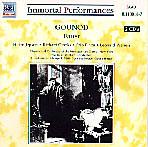 This performance, dated
April 6th, 1940, was recorded with the Met on tour in Boston. It
preserves the Mephistopheles of Ezio Pinza, one of his great roles.
Other than a few flat high notes in Act 1, Pinza's performance is a
vocal and dramatic tour de force. As Faust, Richard Crooks shows why
he was one of a handful of tenors of his generation capable of doing
justice to this role. His "Salut! Demeure" could hardly be better,
complete with a clarion top C followed by a controlled diminuendo.
Valentin is a very youthful Leonard Warren. In resplendent voice, he
lingers over the high notes in "Avant de quitter ces lieux." Helen
Jepson (Marguerite)'s well schooled, pretty voice sans trill
pales in such splendid company. The sound on this Boston broadcast
is far superior to the other Met broadcasts in the Naxos series
originating from New York. Highly recommended. Joseph
So This performance, dated
April 6th, 1940, was recorded with the Met on tour in Boston. It
preserves the Mephistopheles of Ezio Pinza, one of his great roles.
Other than a few flat high notes in Act 1, Pinza's performance is a
vocal and dramatic tour de force. As Faust, Richard Crooks shows why
he was one of a handful of tenors of his generation capable of doing
justice to this role. His "Salut! Demeure" could hardly be better,
complete with a clarion top C followed by a controlled diminuendo.
Valentin is a very youthful Leonard Warren. In resplendent voice, he
lingers over the high notes in "Avant de quitter ces lieux." Helen
Jepson (Marguerite)'s well schooled, pretty voice sans trill
pales in such splendid company. The sound on this Boston broadcast
is far superior to the other Met broadcasts in the Naxos series
originating from New York. Highly recommended. Joseph
So
- Johann Strauss II: Eine Nacht in
Venedig
- Heinrich Steiner \ Reichsender Orchestra
(Naxos 8.1110027-8).
In this vintage 1938 recording from Berlin, Johann Strauss'
classic operetta is heard just as it should be performed on the
stage, with substantial sections of spoken dialogue in between the
musical numbers, offering a unique blend of droll comedy and "light"
virtuoso singing. The idiomatic performers are consummate actors as
well as top-notch singers. The male lead, tenor Marcel Wittrisch,
then at the height of his career, had one of the most exciting
voices ever to grace the German stage, strong and powerful, yet
agile and graceful, and very secure at the top. One must mention
that this live radio recording originated in Nazi Germany. History
tells us that Hitler himself was very fond of Viennese operetta and
that Herr Wittrisch was his favourite singer in that repertoire.
There is evidence that the spoken dialogue heard in this recording
is based on a special "national-socialist" propaganda edition of the
text, which ridicules parliamentary democracy. A difficult
allegation to verify since the operetta is in German and Naxos
suplies no libretto or synopsis in any language. The recording
suffers from surface noise and other technical blemishes but it is
above average for the period and Naxos has made an excellent job of
restoring the best available source tapes put at its disposal by
some mysterious German collector. Pierre M.
Bellemare
- Mozart: Don Giovanni
- Bruno Walter / Metropolitan Opera
- (Naxos 8.110013-4)
This performance captures many Met artists at the height of their
powers - particularly the charismatic Don of Ezio Pinza and the
delicious Zerlina of Bidu Sayao. As Leporello, Alexander Kipnis is
excessively buffo in places, while Charles Kullman makes a
sweet-toned but short-breathed Ottavio, sorely taxed by the
coloratura and the long lines of "Il mio tesoro". Bruno Walter's
muscular and stately conducting is more seria than
commedia, perhaps a bit too heavy-handed for Mozart, but his
command and musical intelligence are never in doubt. It is a shock
to hear secco recitative played on the piano, a practice now
mercifully rarely encountered. More serious are the bleeding chunks
excised from the score, partly a result of standard cuts, such as
Elvira's "Mi tradì," but also due to gaps in the original tapes. On
the bright side, the results fit on two supercheap CDs.
Unfortunately, curtain calls and commentary by Milton Cross are not
preserved. Sonically, the opera is quite listenable, though the
sound is rather constricted and lacking in clarity, especially
compared to the Faust broadcast (Naxos 8.110016-17) recorded
two years earlier. This is an important document and a must for fans
of the Met. Joseph So
- Schubert: Goethe Lieder
- Matthias Goerne, baryton
- London 452-917-2
Le baryton lyrique Matthias Goerne nous propose un récital de
lieder de Schubert sur des textes de Goethe. Sa voix est
d'une beauté et d'une étendue considérables et se distingue par sa
sensibilité. Son style de chant est d'un extrême raffinement qui
parfois frôle l'affectation. Il navigue dans les ultimes
piani (surtout dans les trois «Gesänge des Harfners» et
l'intime «Nähe des Geliebten»), mais déploie la puissance requise
pour «Erlkönig» et «Prometheus». Son accompagnateur, un pianiste
discret et fort sensible, fils du ténor Ernst, se nomme Andreas
Haefliger. Ce récital, que je recommande chaudement, nous met l'eau
à la bouche pour le prochain album de Goerne, Lieder de
Schumann, a paraître en avril. Richard Turp
- J.S. Bach: The Brandenburg
Concertos
- Gustav Leonhard. SEON SB2K 62946
(Sony)
Gustav Leonhardt was one of the founders of the early music
revival and his colleagues here (Sigiswald Kuijken, Frans Brüggen,
Anner Bylsma) are a veritable Who's Who of baroque music
specialists. In the first concerto, the sound of the natural horns
is a bit brash and the tempo of the Menuet is rather
weighty, but these are minor complaints. Special mention must be
made of Claude Rippas' trumpet playing in the second concerto and
that of cellist Anner Bylsma in the sixth. Leonhardt's direction is
informed without being stuffy. Despite the passage of time this
economically priced recording remains enjoyable. Casey Ann
Reinke
- Arie Antiche
- Dmitri Hvorostovsky, baritone
- Sir Neville Marriner / Academy of St. Martin
in the Fields (Philips 456 543-2)
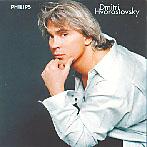 Since his 1988 win in
the pretentiously named Cardiff Singer of the World Competition,
36-year old Siberian baritone Dmitri Hvorostovsky’s good looks and
opera career as a Verdi baritone have kept him in the public eye.
Now he offers us an album of Baroque Italian arias and the results
are charming, especially in slow, reflective arias such as Gluck’s
"O mio dolce ardor", Caldara’s "Selve amiche" and "Come raggio di
sol", Handel’s "Chi sprezzando", and Caccini’s haunting "Amarilli,
mia bella" (arranged by the baritone himself). The voice is warm,
resonant, straight (no ragged Terfel vibrato), slightly covered and
smoky, with almost no Slavic accent. His Italian diction is very
fine and he seems temperamentally suited to the repertoire. Only in
the two coloratura Vivaldi arias and in sprightly songs such as
Giordani’s "Caro mio ben" and Handel’s "Già il sole del Gange"
(Gigli territory!) does Hvorostovsky lack agility and sparkle. Since his 1988 win in
the pretentiously named Cardiff Singer of the World Competition,
36-year old Siberian baritone Dmitri Hvorostovsky’s good looks and
opera career as a Verdi baritone have kept him in the public eye.
Now he offers us an album of Baroque Italian arias and the results
are charming, especially in slow, reflective arias such as Gluck’s
"O mio dolce ardor", Caldara’s "Selve amiche" and "Come raggio di
sol", Handel’s "Chi sprezzando", and Caccini’s haunting "Amarilli,
mia bella" (arranged by the baritone himself). The voice is warm,
resonant, straight (no ragged Terfel vibrato), slightly covered and
smoky, with almost no Slavic accent. His Italian diction is very
fine and he seems temperamentally suited to the repertoire. Only in
the two coloratura Vivaldi arias and in sprightly songs such as
Giordani’s "Caro mio ben" and Handel’s "Già il sole del Gange"
(Gigli territory!) does Hvorostovsky lack agility and sparkle.
- Antonio Caldara: Maddalena ai piedi di
Cristo
- René Jacobs / Orchestre de la Schola Cantorum
Basiliensis
- harmionia mundi (HMC 905221.22 / SRI)
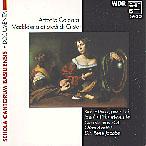 This dramatic cantata
won a well-deserved 1997 Gramophone award for best baroque vocal
recording. Caldara’s score is packed with irresistible tunes and
ravishing arias (there are 27 exquisite little da capo
arias). Six stunningly fresh young voices including Argentinian
mezzo Bernarda Fink and soprano Rosa Dominguez sing the roles of
Earthly and Celestial Love, the Magdalen, Martha, a Pharisee and
Christ. Countertenor Andreas Scholl sounds as pure and powerful as a
silver flute. Jacobs conducts with envigorating dramatic flair. This
is a must for anyone even remotely appreciative of baroque
musicianship. This dramatic cantata
won a well-deserved 1997 Gramophone award for best baroque vocal
recording. Caldara’s score is packed with irresistible tunes and
ravishing arias (there are 27 exquisite little da capo
arias). Six stunningly fresh young voices including Argentinian
mezzo Bernarda Fink and soprano Rosa Dominguez sing the roles of
Earthly and Celestial Love, the Magdalen, Martha, a Pharisee and
Christ. Countertenor Andreas Scholl sounds as pure and powerful as a
silver flute. Jacobs conducts with envigorating dramatic flair. This
is a must for anyone even remotely appreciative of baroque
musicianship.
- Glazunov and Kabalevsky: Violin
Concertos
- Tchaikovsky: Souvenir d'un lieu cher;
Valse-Scherzo
- Gil Shaham, violin
- Mikhail Pletnev / Russian National
Orchestra
- Deutsche Grammophon 457 064-2
All four works on this disc are relatively unfamiliar, but if
they were always played so ravishingly they would surely be recorded
more often. Gil Shaham justifies his formidable reputation with
memorable accounts to stand alongside the best. His technique,
albeit stunning, is only a means to an end, never an end in
itself.
Shaham plays with the kind of wide tonal palette one would expect
of a great singer. Interpretively he is very similar to Josef
Gingold, former concertmaster of the Cleveland Orchestra. This is
extroverted old-fashioned bravura playing, full of liberal
portamenti and rubati. These are particularly
effective in the playful Valse-Scherzo, where Shaham's finely
controlled spiccato permits him to freely indulge in
quixotic agogic effects. Mikhail Pletnev draws fine though not
exceptional playing from the Russian National orchestra. Added
reverberation, though unnatural, doesn't impair one's enjoyment of
the music. Heartily recommended. Gil Shaham will play the
Barber Concerto with the Toronto Symphony Orchestra April 15
@ 20H00 & April 16 @ 11H00, 1998 (Tickets: 416-593-4828). Shaham
in recital at the National Arts Centre May 15, 1998 (Ticketmaster:
613-755-1111). Alan Horgan
|


